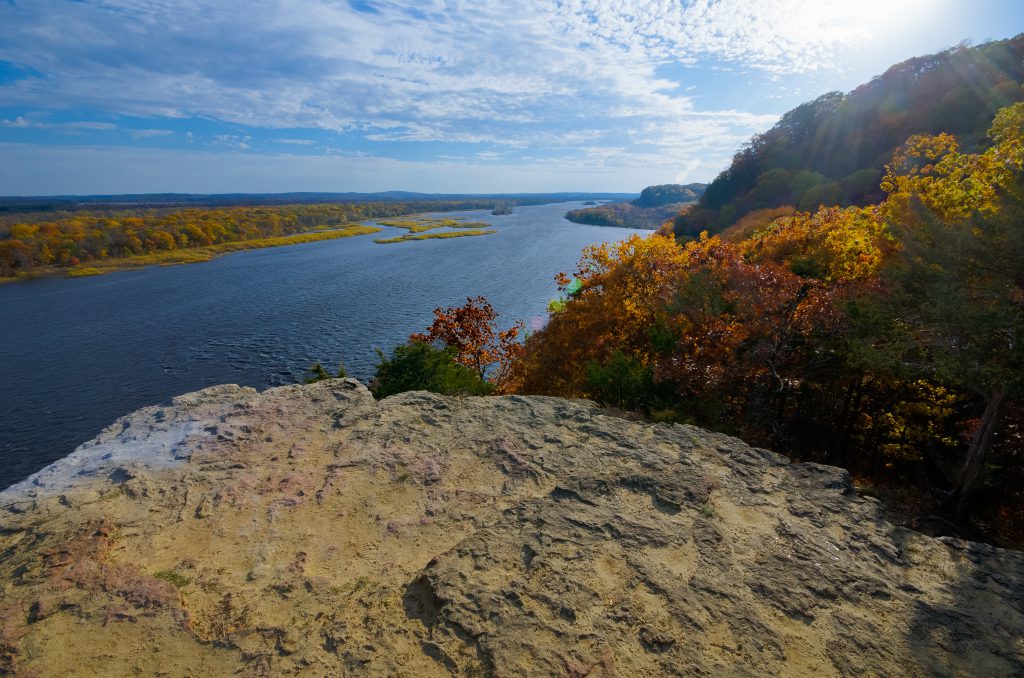Natural Areas Program Protects State’s Beauty
State program created 70 years ago protects 500,000 acres at 692 sites across Wisconsin.

Ferry Bluff Wisconsin State Natural Area #217. Photo by Joshua Mayer from Madison, WI, USA / (CC BY-SA).
Many things make Wisconsin special: our dairy products, our people, the Packers and our splendid natural heritage. While we can be sure that our cheese will always be the best, Wisconsinites resilient and the Pack our team, we can’t be so certain that the bounty and beauty of our natural environment will endure.
Wisconsin is blessed with varied landscapes and diverse ecological communities. More than 75 unique types of natural communities graced our state before European settlement, ranging from hardwood and pine forests to millions of acres of prairie and savanna as well as vast wetlands and natural features attributable to both glaciated and Driftless geology. These differing environments provided habitat for a wide variety of fauna and flora.
Many of the areas that typify our landscape have been lost to development and agriculture. Those that remain are often endangered. Fortunately, an outstanding and largely successful state program established almost 70 years ago “protects outstanding examples of Wisconsin’s native landscape of natural communities, significant geological formations and archaeological sites.”
SNAs are numbered chronologically based on when they were established. State Natural Area Number 1, dating back to 1952, is Parfrey’s Glen in Sauk County — that magical canyon on the south slope of the Baraboo Hills. The most recent SNA, number 692, was designated just last year. It’s the North Pikes Creek Boreal Forest in Bayfield County, a high-quality forest set in rugged terrain near the shore of Lake Superior. Most SNAs are open to the public, although there may be limits as necessary to preserve endangered habitat. The DNR website has a good listing of the areas with maps and descriptions.
Natural areas are some of my favorite places in Wisconsin to visit, and I have explored a great many by hiking, snowshoeing and paddling. One of my favorites is Ferry Bluff along the Lower Wisconsin River. Ferry Bluff and the adjacent Cactus Bluff are sandstone cliffs that tower more than 300 feet above the confluence of the Wisconsin River and Honey Creek. They afford marvelous views of the river, Blue Mounds and surrounding countryside. It’s home to deep forests, prairie flowers, numerous ferns and, yes, cactus and is a valuable roosting site for our national symbol, the bald eagle.
When I developed the Stewardship Fund 30 years ago, one of my top priorities was providing funding to expand the natural areas program, and many SNAs have been protected by stewardship. More than 90 natural areas encompassing 43,000 acres have been purchased directly by DNR using stewardship funding including Bailey’s Harbor Boreal Forest, Chiwaukee Prairie, the Dells of the Wisconsin River, and Ridgeway Pine Relict. In addition, stewardship grants have enabled nonprofit conservation organizations to protect 41 additional SNAs.
I thought it essential to include funding for the State Natural Areas as a key part of the Stewardship Fund because I believe we have an obligation to preserve the best examples of our natural beauty, biological diversity and varied landscape for future generations to enjoy and gain inspiration.
This column was originally published by the Cap Times in Madison.
Spencer Black represented the 77th Assembly District for 26 years and was chair of the Natural Resources Committee.
Op-Ed
-
Wisconsin Candidates Decry Money in Politics, Plan to Raise Tons of It
 Dec 15th, 2025 by Ruth Conniff
Dec 15th, 2025 by Ruth Conniff
-
Trump Left Contraceptives to Rot; Women Pay the Price
 Dec 8th, 2025 by Dr. Shefaali Sharma
Dec 8th, 2025 by Dr. Shefaali Sharma
-
Why the Common Council’s Amended Budget is Good Policy for Milwaukee
 Nov 20th, 2025 by Alds. Marina Dimitrijevic and Russell W. Stamper, II
Nov 20th, 2025 by Alds. Marina Dimitrijevic and Russell W. Stamper, II




















